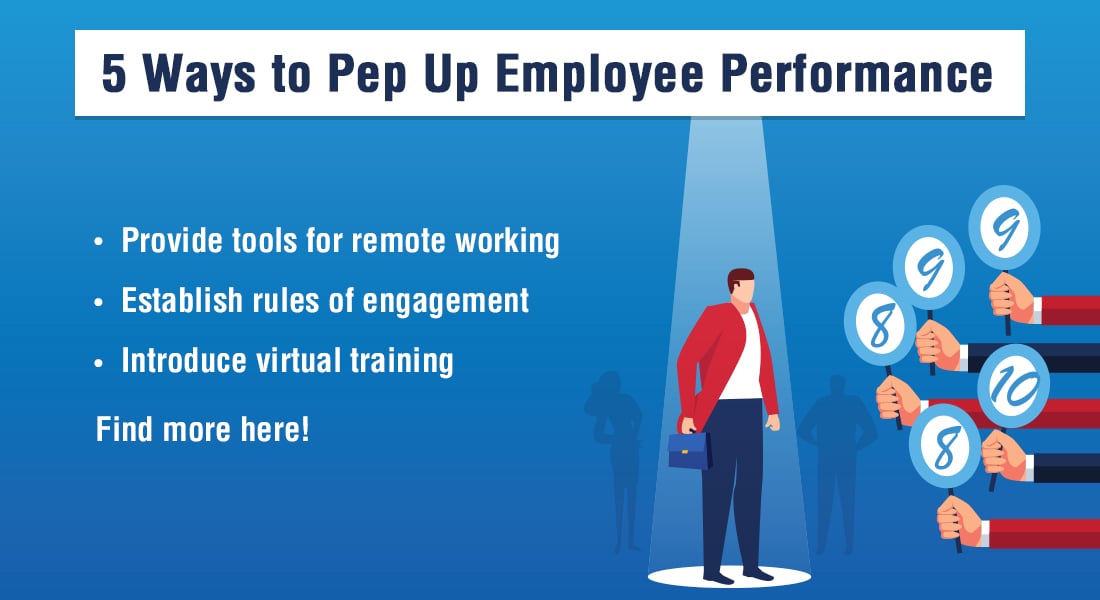5 Steps to Analyze If Online Training Can Improve Employee Performance

An organization is only as good as its employees. As clichéd as it might sound, this phrase holds good for every company. When employee performance is good, it has a positive impact on the company’s growth. There are many ways to improve employee performance, one of which is training, and this can happen in the classroom, online, or by following a combination of both classroom and online training.
5 Steps to Analyze if Online Training Can Solve Problems with Employee Performance
- Identify the employee performance problem
- Check if the problem is worth fixing using training
- Find out if you can offer a quick fix
- Check if employees have the required skills
- Ensure it isn’t a case of forgotten skills
As a result of living in the digital age, we’ve come to increasingly rely on technology and digital devices for our training needs. But is online training or eLearning the right solution always?
5 Steps to Analyze if Online Training Can Solve Employee Performance Problems
Let’s assume your organization is focused on using online training as a corporate training strategy. Are you sure online training can always provide a solution for employee performance problems? Here’s a 5-step analysis inspired by Robert F. Mager and Peter Pipe’s work in their book ‘Analyzing Performance Problems’.
1. Identify the Employee Performance Problem
To design a training solution, be it online or classroom, you need to be clear about the performance problem. What is the problem you’re trying to solve through training? Here are the questions you need to find answers to:
- What is the current work performance of the employee?
- What is the expected performance?
Note down the discrepancy or in other words, the ‘performance gap’.
Consider the example of a customer service team. You’ve identified that customer service executives haven’t been able to solve customer problems satisfactorily and off late there has been a rise in customer complaints.
Let’s say the data on current performance shows the team is only able to solve 65% of customer problems and the expected performance is 100%. There clearly is a performance gap that needs to be bridged. Now whether online training can offer a solution, remains to be seen. Move on to Step 2.
| Note:Training only works if there is a gap in knowledge or skills. If an employee lacks motivation, does not have the aptitude for the job, or lacks resources to perform the job, training cannot offer a solution. |
For tips on improving work performance, please check this video.
2. Check if the Performance Problem is Worth Fixing through Training
Are all employee performance problems worth fixing using training? You’ve identified the performance gap in Step 1. Don’t make the mistake of immediately prescribing an online training on customer service. The visible issue may not actually be the real problem. You will have to delve deeper. Before you decide on a course of action, gather actionable feedback from your employees. You could use surveys or even one-on-one meetings to gather feedback.
Here are two hypothetical results of feedback analysis:
Customer complaints were unresolved because they required a service technician to go to the customer’s site and troubleshoot the problem in the product. You also gather that the organization is facing a shortage of resources (in this case skilled service technicians), which is why many customer complaints have been left unattended.
Wouldn’t online training have been such a waste in this scenario? The solution in this case is not to get employees to complete an online course on customer service; instead, it is to hire more service technicians.
Customer complaints were unresolved because new team members were unaware of the process to be followed, be it logging a customer complaint, troubleshooting product problems, guiding customers on its usage, or even simply escalating the problem to a supervisor.
The feedback analysis in this case clearly points to lack of knowledge and skills and is worth fixing using online training.
Now that you’ve checked if it’s worth using eLearning to correct employee performance problems, you’re ready to move on to Step 3.
| Note: The problem that’s visible may not be the actual reason for poor employee performance. So, delve deeper. |
3. Find Out if You Can Offer a Quick Fix
Continuing with the earlier example, assume that a majority of customer complaints could have been resolved if customer service agents had followed a proper escalation process. Now, would this require an online training program? Not really.
You could simply design a job-aid that lists the steps customer service executives must follow to escalate a problem. While seasoned employees might not need this, it would certainly benefit new hires in the team.
In this case the solution is simple, but it works well and eliminates the need for a full-fledged training program.
Ask yourself this question:
Are employees clear with what’s expected from them?
This is a common problem when employees are new, or they lack knowledge about the organization’s products, processes, or services. It may not be possible to offer a quick fix in such situations.
Set clear expectations. You could consider investing in a new hire training program that can help employees who are new to your workforce understand the organization, its culture, and what’s expected from them (e.g.: Compliance training and Code of Conduct training). Consider training solutions to provide knowledge training. (e.g.: Product or process training).
If you’ve identified that a quick fix will not work, simply move on to Step 4.
| Note: Always check if employees are clear with the tasks they are expected to complete at work. |
4. Check if Employees Have the Required Skills
As training managers, most of you might have encountered situations where a senior manager or a functional head of a particular department approaches you to design a training solution for his/her team.
Taking the example mentioned earlier, assume the manager of the customer service team tells you that supervisors in the team are finding it difficult to communicate and work with their direct reports and requires an online training program on communication and team building skills to be rolled out to these employees (the direct reports).
You do want to provide the best training program to solve the manager’s problem. So, do you immediately go about finding answers to questions such as “how many people need to take this eLearning course?” or “how to zero in on an eLearning vendor to complete this task?” or “how long the online training should be?” There’s nothing wrong in asking these questions, you obviously would need answers to these questions if you’ve to rollout effective online training programs.
However, if you want to analyze if online training can fix the problem, deviate from the conventional way of thinking. Think in terms of performance. Get answers to questions such as:
- Is this a new problem or a persisting one?
- Do the supervisors communicate well?
- Are the supervisors setting an example through exemplary teamwork?
- Are the supervisors aware of the manager’s expectations?
You are required to think like a performance consultant. Who knows at the end of your analysis, you might even conclude that it’s not the direct reports but the supervisors who need training.
Alright, that was a far-fetched idea. Assuming that the manager was right in requesting for a training program to improve employee performance, leverage eLearning to close the skills gap. Now, there is one other situation you might want to consider before opting for a full-fledged online training program. Move on to Step 5.
| Note: Think like a performance consultant and find out if employees have the required skills. |
5. Ensure It Isn’t a Case of Forgotten Skills
Before you take that decision to opt for online training to solve employee performance problems, ensure that this isn’t a case of forgotten skills.
Referring to the same example, what if customer service agents had gone through a classroom training program before they started the job? If you want to cut down training cost, converting classroom training to eLearning is something that you could consider. You can also quickly scale up training, especially when you have employees located in diverse geographical locations. When you convert ILT to eLearning, you also have the added advantage of rolling out eLearning translations. You could also convert part of the ILT program to eLearning to design a blended learning program.
If you feel the solution lies in brushing up skills, provide reinforcement of training. You could use microlearning modules to beat the forgetting curve.
| Note: Small bites of learning can boost knowledge retention and provide effective reinforcement of training. |
After you’ve identified the online training methodology that would work for your training needs, decide whether you want to outsource eLearning development or complete it in-house (if you have the right resources and skill sets).
A Checklist
Here’s a checklist you can use to analyze if online training is indeed the right solution to your employee performance woes.
|
S.No |
Checklist Questions |
Your Response |
| 1 | Have you identified the problem with employee performance? | |
| 2 | Is it worth using online training to fix the problem? | |
| 3 | Is it possible to offer a quick fix for the problem? | |
| 4 | Do employees lack the required skills? | |
| 5 | Have employees forgotten the required skills? |
If you’ve answered ‘Yes’ to the first four questions, you might want to consider online training to fix employee performance woes, and your answer to the last question can help you judge if you need to go for full-fledged online training or invest in short nuggets of learning. Our eBook on ’32 eHacks to JumpStart Your eLearning’ can prove to be a useful resource in your online training endeavors.





